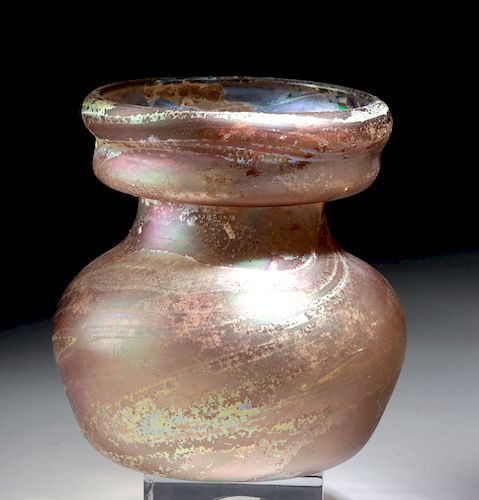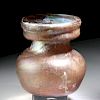Stunning Roman Glass Jar - Aubergine
Lot 26
About Seller
Artemis Fine Arts
686 S Taylor Ave, Ste 106
Louisville, CO 80027
United States
Selling antiquities, ancient and ethnographic art online since 1993, Artemis Gallery specializes in Classical Antiquities (Egyptian, Greek, Roman, Near Eastern), Asian, Pre-Columbian, African / Tribal / Oceanographic art. Our extensive inventory includes pottery, stone, metal, wood, glass and textil...Read more
Estimate:
$1,000 - $1,500
Absentee vs Live bid
Two ways to bid:
- Leave a max absentee bid and the platform will bid on your behalf up to your maximum bid during the live auction.
- Bid live during the auction and your bids will be submitted real-time to the auctioneer.
Bid Increments
| Price | Bid Increment |
|---|---|
| $0 | $25 |
| $300 | $50 |
| $1,000 | $100 |
| $2,000 | $250 |
| $5,000 | $500 |
| $10,000 | $1,000 |
| $20,000 | $2,500 |
| $50,000 | $5,000 |
| $100,000 | $10,000 |
| $200,000 | $20,000 |
About Auction
By Artemis Fine Arts
Apr 4, 2019
Set Reminder
2019-04-04 10:00:00
2019-04-04 10:00:00
America/New_York
Bidsquare
Bidsquare : Ancient / Ethnographic From Around The World
https://www.bidsquare.com/auctions/artemis-gallery/ancient-ethnographic-from-around-the-world-4003
Ancient art from Egypt, Greece, Italy and the Near East, as well as Asian, Pre-Columbian, Native American, African / Tribal / Oceanic, Spanish Colonial, Russian Icons, Fine art, much more! All categories, all price ranges... all legally acquired and guaranteed to be as described or your money back Artemis Fine Arts info@artemisfinearts.com
Ancient art from Egypt, Greece, Italy and the Near East, as well as Asian, Pre-Columbian, Native American, African / Tribal / Oceanic, Spanish Colonial, Russian Icons, Fine art, much more! All categories, all price ranges... all legally acquired and guaranteed to be as described or your money back Artemis Fine Arts info@artemisfinearts.com
- Lot Description
Roman, Imperial Period, ca. 2nd to 3rd century CE. A wonderfully-preserved, free-blown translucent glass vessel of a squat form and pale aubergine color. The bulbous body has a concave base with a large pontil scar, a rounded shoulder, a narrow neck, and a collared rim which leads to a deep interior cavity. Extensive exterior areas of silvery and rainbow-hued iridescence complement the vessel's aubergine hue, especially around the body. Size: 3.75" W x 4" H (9.5 cm x 10.2 cm)
Ancient glass manufacture had begun in the 2nd millennium BCE in Mesopotamia and Egypt. The Greeks and Phoenicians advanced glass technology greatly in the latter 1st millennium BCE. In the early 1st century CE, Roman workshops began producing blown glass on a large scale. Eventually glass vessels came to replace a wide variety of pottery and metal wares in the ancient world. Ancient Roman glass was traded far beyond the Roman Empire. Roman glass vessels have been found in Scandinavia, India, and in Han Dynasty tombs in China.
A similar example (and an additional vessel) hammered for $5,000 at Christie's, New York "Antiquities Including Property from The Collection of Max Pavelsky" Auction (sale 2364, December 9, 2010, part of lot 75 [left-most vessel]): https://www.christies.com/lotfinder/ancient-art-antiquities/two-roman-glass-vessels-circa-1st-4th-century-5385381-details.aspx?from=searchresults&intObjectID=5385381&sid=679c854e-78f4-43b5-8346-9770bf662644
Provenance: private East Coast, USA collection; ex-Stephen Shalom collection, New York, USA, acquired in the 1970s
All items legal to buy/sell under U.S. Statute covering cultural patrimony Code 2600, CHAPTER 14, and are guaranteed to be as described or your money back.
A Certificate of Authenticity will accompany all winning bids.
We ship worldwide and handle all shipping in-house for your convenience.
#142890Intact. Surface wear and light abrasions commensurate with age as expected, and light roughness around rim and base. Light earthen deposits as well as lovely silvery and rainbow iridescence throughout. Vessel possesses a pontil scar or mark which indicates that the vessel was free-blown. (The absence of such a mark would suggest that the work was either mold-blown or that the mark was intentionally smoothed away or worn away over time.)Condition
- Shipping Info
-
All shipping is handled in-house for your convenience. Your invoice from Artemis Gallery will include shipping calculation instructions. If in doubt, please inquire BEFORE bidding for estimated shipping costs for individual items.
-
- Buyer's Premium



 EUR
EUR CAD
CAD AUD
AUD GBP
GBP MXN
MXN HKD
HKD CNY
CNY MYR
MYR SEK
SEK SGD
SGD CHF
CHF THB
THB
















